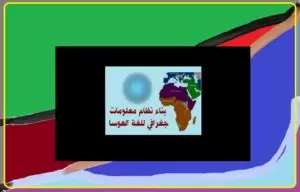بناء نظام معلومات جغرافي للغة الهوسا
بناء نظام معلومات جغرافي للغة الهوسا دراسة حالة للطلاب النيجيرين بمعهد البحوث والدراسات الإفريقية بجامعة القاهرة
اللغة أصوات يعبر بها كل قوم عن أغراضهم، وهذه الأصوات ينتجها جهاز النطق في الإنسان معبراً بها عما يحس به من حاجات، واللغة ليست أصواتاً فحسب، بل هى نظام من الرموز الصوتية، تحمل دلالات مختلفة تهدف إلى التواصل بين أفراد المجتمع، وهو نظام متكامل نجح في تحقيق الهدف السابق (التواصل)، وهذه الرموز الصوتية المحدودة تكون نظاماً مركباً معقداً من الأصوات المتتابعة، والتى يتكون منها آلاف الكلمات وملايين الجمل. ولهذا تعد اللغة نظاماً صوتياً إشارياً.

وتعد لغة الهوسا أكثر اللغات انتشاراً في إفريقيا جنوب الصحراء، وهي اللغة السائدة في نيجيريا الشمالية والكاميرون وفي المنطقة المجاروة من جمهورية النيجير، ويقدر عدد أبناء الهوسا بما لا يقل عن خمسة عشر مليوناً، ويتعامل بها من غير أبنائها عدد لا يقل عن عشرة ملايين. وهناك جماعات تتعامل بلغة الهوسا في مواقع مختلفة في إفريقيا الغربية وإفريقيا الاستوائية. وهي أشهر اللغات التشادية التابعة بدورها للعائلة الأم عائلة اللغات الأفروآسيوية.
والبحث يتناول بالدراسة والتحليل التباين اللغوى للغة الأصلية للطلاب النيجيرين بالمعهد ولغة الدراسة التي يدرسون بها في برامج الماجستير والدكتوراه، وكذلك اللغة الإنجليزية باعتبارها اللغة العلم الدولية التي من المفترض أن يتعامل بها الطلاب الدارسين مع مدرسيهم. وتأتي الخطوات الاجرائية للبحث في إجراء استبيان على عينة عشوائية من الطلاب والأساتذة المصريين الذين أُعيروا لدولة نيجيريا للتدريس بإحدى جامعاتها وكذلك مدرسو اللغة النيجيرين بقسم اللغات الإفريقية والطلاب النيجيرين بالمعهد، وتفسير مدى الإزدواجية اللغوية بين اللغات الثلاثة العربية، الهوسا والإنجليزية، وبناء نموذج محاكاة مكانى داخل نظم المعلومات الجغرافية للخروج بنتائج تحليلية ذات رابط مكانى لغوى.
الكلمات الدالة : نظم المعلومات الجغرافية – النمذجة – لغة الهوسا – التحليل المكانى –
التباين اللغوي .
د. إيمان عبدالعظيم عبدالرحمن[1] د. حماد اسماعيل فوزى صادق[2]
[1] قسم الجغرافيا – كلية الآداب ، جامعة القاهرة
[2] مدرس مساعد بقسم اللغات الإفريقية ، لغة الهوسا، معهد البحوث والدراسات الإفريقية ، جامعة القاهرة
